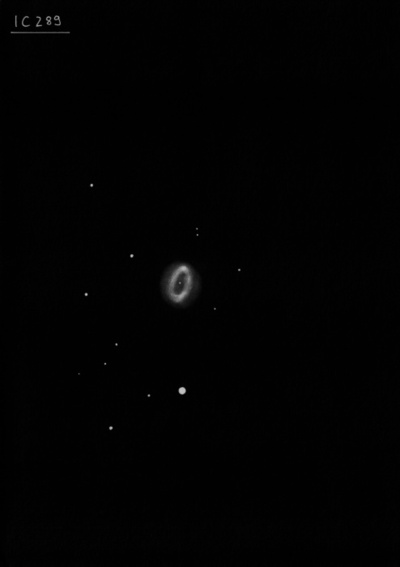
Lewis Swift discovered IC 289 = Sw. VIII-15 on 2 Sep 1888 and recorded "pB; pL; R; bet 2 vF st."
Hubble included this object in a 1921 paper titled "Twelve New Planetary Nebulae" in PASAP, Vol 33, No 193, p. 174 available at http://cdsads.u-strasbg.fr/cgi-bin/nph-iarticle_query?1921PASP...33..174H. Included in his table are NGC 2818, NGC 6072, NGC 7048, NGC 7635, IC 289, IC 1470, IC 4670, Hb 4, Hb 5, Hb 7, Hb, 8 and Hb 12.
200/250mm - 8" at 100x and UHC filter this planetary is very faint, very small. Situated near the tip of two converging rows of mag 10-12 stars. Several difficult positive sightings made from poor transparency in El Cerrito!
300/350mm - 13" (12/7/85): at 79x and OIII filter appears faint, small, round. At 166x and UHC filter can just hold steadily with averted vision, fairly small, almost round.
400/500mm - 17.5" (1/16/02): at 140x, IC 289 was seen as a fairly faint, 35" to 40" disc with a modest contrast gain using a UHC filter. Situated 2' N of a mag 10 star and near the tip of two curving strings of stars which head north and NW from IC 289. Excellent view at 380x - the planetary is slightly elongated and has a mottled appearance with a marginally brighter rim, particularly on the W or NW side, giving an impression of weak annularity. At moments, there was a brief sparkle at the center, possibly the central star. A mag 14 star is 45" NE of center and a mag 13 star lies 1.3' following.
900/1200mm - 48" (10/27/16): at 610x unfiltered; bright, fairly large, slightly elongated NW-SE. Annular with an irregularly brighter rim that is brightest on the northwest side. The northern end is slightly brighter in general (less than a 90° arc). A faint central star was visible most of the time. We didn't look for the outer halo at lower power. IC 289 resides in a rich star 1.8' NNW of a mag 10.1 star.
48" (10/25/14): at 375x unfiltered; fairly bright, fairly small, slightly elongated NW-SE, 0.6'x0.5'. Weakly annular with a slightly brighter rim and irregularly lit darker center that contains a very faint central star. A thin, very low surface brightness outer halo is more elongated along the minor axis, creating a roughly circular halo.
Notes by Steve Gottlieb